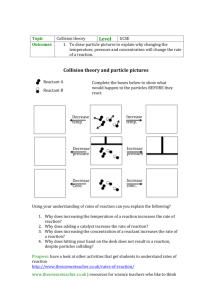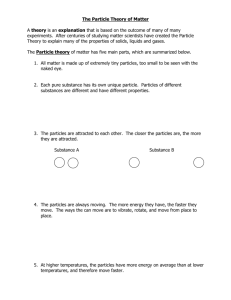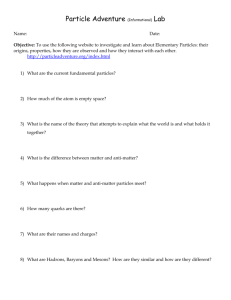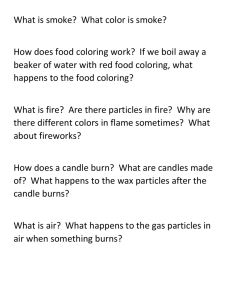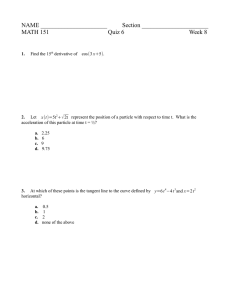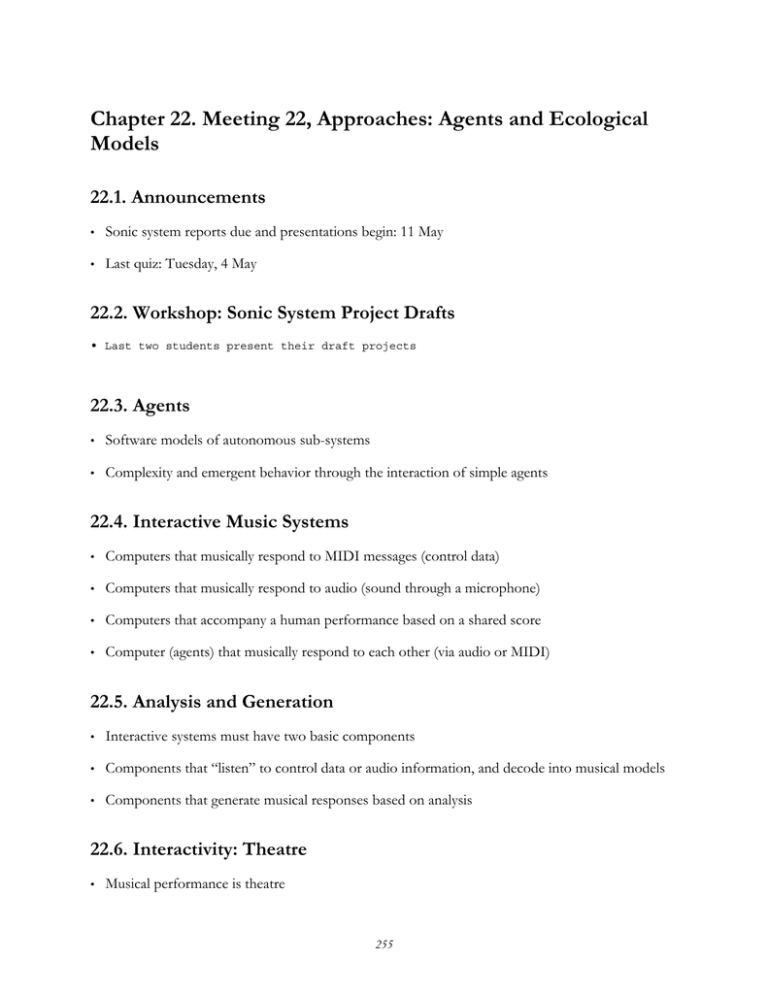
Chapter 22. Meeting 22, Approaches: Agents and Ecological
Models
22.1. Announcements
•
Sonic system reports due and presentations begin: 11 May
•
Last quiz: Tuesday, 4 May
22.2. Workshop: Sonic System Project Drafts
• Last two students present their draft projects
22.3. Agents
•
Software models of autonomous sub-systems
•
Complexity and emergent behavior through the interaction of simple agents
22.4. Interactive Music Systems
•
Computers that musically respond to MIDI messages (control data)
•
Computers that musically respond to audio (sound through a microphone)
•
Computers that accompany a human performance based on a shared score
•
Computer (agents) that musically respond to each other (via audio or MIDI)
22.5. Analysis and Generation
•
Interactive systems must have two basic components
•
Components that “listen” to control data or audio information, and decode into musical models
•
Components that generate musical responses based on analysis
22.6. Interactivity: Theatre
•
Musical performance is theatre
255
•
Appeal of technological achievement or drama of technological disaster
22.7. Applications of Multi-Parameter Feature Extraction
•
Detect articulation, pitch, and tempo and match to a score: score following
•
Detect articulation, pitch, and rhythms, and build musical responses: interactive systems,
installations
22.8. Multi-Parameter Feature Analysis in PD
•
[fiddle~] object: pitch, event, and amplitude
22.9. Early Historical Examples of Interactive Music Systems
•
1967: Gordon Mumma’s Hornpipe (1967): “an interactive live electronic work for solo hornists,
cybersonic console, and a performance space”; system analyzes sound form horn and in
performance space
256
Audio: local
(file://localhost/Volumes/xdisc/_sync/_x/eduMitCourses/21m380b/audio/mummaHornpipe.
mp3)
•
1968: Max Mathews and F. Richard Moore develop GROOVE system at Bell Labs. Real-time
performance interface to a predetermined musical score
•
1979: George Lewis, with a KIM-1 computer, develops interactive compositions designed to
work with improvisation
•
1983: Felix Hess creates 40 Electronic Sound Creatures, small mobile machines with microphones
and speakers that respond to each other an the envrionment
© Felix Hess/John Stoel. All rights reserved. This content is excluded from our
Creative Commons license. For more information, see http://ocw.mit.edu/fairuse.
•
1987: Robert Rowe develops a system called Cypher, consisting of a Listener, a Player, and a
Critic, used in Flood Gate (1989)
257
22.10. Reading: Rowe: Machine Listening and Composing with Cypher
•
Rowe, R. 1992. “Machine Listening and Composing with Cypher.” Computer Music Journal 16(1):
43-63.
•
What types of features are extracted during the first level of listener analysis?
•
What types of features are extracted during the second level of analysis?
•
How does the chord and key analysis routines work?
•
What are the three compositional methods employed?
•
What is the role of the critic?
•
How is the large-scale behavior of the system varied over time?
22.11. Listening: Rowe
•
Listening: Robert Rowe, Shells, 1993
22.12. Listening: Ariza
•
Listening: Christopher Ariza, to leave the best untold, 2009
22.13. Alternative Agent Models
•
Analogies to human roles
•
Analogies to ecological models
•
Analogies to social systems
•
Analogies to physical systems
22.14. A Model of Particle Feedback Systems
•
Particles in a dynamic system
258
•
Particles
•
Have one or more states, each state with a discrete life span
•
Particle expired at termination of life span
•
Life cycle:
[('a', 1), ('b', 2)]
•
Particle Transformers
•
Have one or more states, each state with a discrete life span
•
Particle expired at termination of life span
•
State determines focus of particle
•
Focus is target state looked for in other particles; transformed with transformation map
•
Transform map:
{'a':[(None, 3), ('a', 1)]}
•
•
Related to first order Markov chain
Sensor Producers
•
Produces one type of Particle
•
Produces one type of Particle Transformer
•
Stores a threshold, a target value for a given state
•
Senses the composition of a collection of Particles
•
Stores a production count range: given difference from threshold, give a range of Particles to
produce (when below threshold) or Particle Transformers to produce (when above threshold).
•
Production count range:
{(-30,-10): [1,2], (1,10): [1, 2], (11, 20): [1, 4], None: [1, 8]}
•
Environment
•
Store lists of Sensor Producers, Particles, and Particle Transformers
•
Provides model of Sensor Producer (one for now)
•
Provides an absolute discrete value range for sensed particle
259
•
Specify number of sensors
•
Can age all Particles by one or more age steps
22.15. Feedback System as ParameterObject
•
The feedbackModelLibrary ParameterObject
:: tpv fml
Generator ParameterObject
{name,documentation}
FeedbackModelLibrary feedbackModelLibrary, feedbackModelName, parameterObject,
parameterObject, min, max
Description: Produces values from a one-dimensional string
rewrite rule, or Lindenmayer-system generative grammar. The
terminus, or final result of the number of generations of
values specifed by the stepCount parameter, is used to
produce a list of defined values. Values are chosen from
this list using the selector specified by the
selectionString argument. Arguments: (1) name, (2)
feedbackModelName, (3) parameterObject {aging step}, (4)
parameterObject {threshold}, (5) min, (6) max
•
A basic model of a Thermostat: particles as heat
:: tpmap 100 fml,t,(bg,rc,(1,1.5,2))
feedbackModelLibrary, thermostat, (basketGen, randomChoice, (1,1.5,2)),
(constant, 0.9), (constant, 0), (constant, 1)
TPmap display complete.
•
Dynamic age values applied to Particles
:: tpmap 100 fml,t,(ls,e,(c,30),0,4)
feedbackModelLibrary, thermostat, (lineSegment, (constant, 30), (constant, 0),
(constant, 4)), (constant, 0.9), (constant, 0), (constant, 1)
TPmap display complete.
260
•
Climate control: produce both Particles and Particle Transformers
:: tpmap 100 fml,cc,(bg,rc,(.5,1,1.5))
feedbackModelLibrary, climateControl, (basketGen, randomChoice, (0.5,1,1.5)),
(constant, 0.9), (constant, 0), (constant, 1)
TPmap display complete.
•
Alternative approaches to PO interface?
22.16. Feedback System as Dynamic Contour
•
Can treat the grammar alphabet as parameter values: integers, floating point values
•
Command sequence:
•
emo mp
•
tmo lg
•
tin a 66
•
constant pulse
tie r pt,(c,8),(c,1),(c,1)
•
amplitude controlled by Thermostat feedback
tie a fml,t,(bg,rc,(1,1.5,2))
•
using convert second to set durations
261
tie r cs,(fml,t,(c,1),(c,.7),.001,.400)
•
amplitude controlled by Climate Control feedback
tie a fml,cc,(bg,rc,(.5,1,1.5)),(c,.7),0,1
•
eln; elh
22.17. Feedback System as Path Index Values
•
Feedback system states as index values from the Path
•
Command sequence:
•
emo m
•
create a single, large Multiset using a sieve
pin a 5@1|7@4,c2,c7
•
tmo ha
•
tin a 107
•
constant rhythm
tie r pt,(c,4),(c,1),(c,1)
•
select only Multiset 0
tie d0 c,0
•
create only 1 simultaneity from each multiset; create only 1-element simultaneities
tie d2 c,1; tie d3 c,1
•
select pitches from Multiset using Thermostat
tie d1 fml,t,(bg,rc,(1,1.5,2)),(c,.7),0,18
•
select pitches from Multiset using Climate Control
tie d1 fml,cc,(bg,rc,(.5,1,1.5)),(c,.7),0,18
•
eln; elh
262
MIT OpenCourseWare
http://ocw.mit.edu
21M.380 Music and Technology: Algorithmic and Generative Music
Spring 2010
For information about citing these materials or our Terms of Use, visit: http://ocw.mit.edu/terms.

